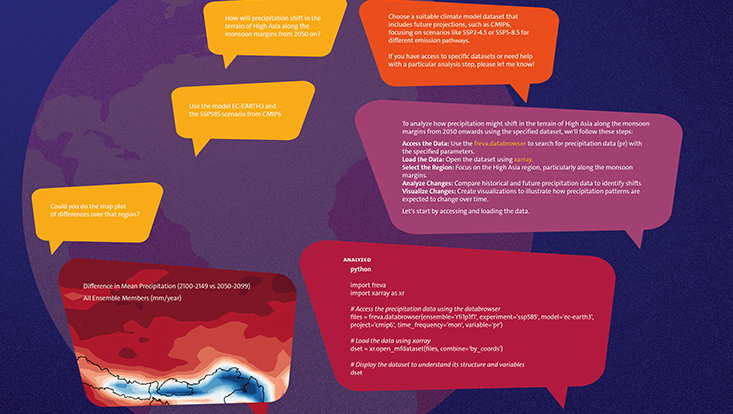and Society (CLICCS)
No tall tales, chatbot!
21 July 2025, by Stephanie Janssen

Photo: Franziska Neigenfind
Artificial Intelligence is currently revolutionizing virtually every aspect of our lives. At the German Climate Computing Center, Dr. Christopher Kadow is exploring how AI can be applied in climate research. In the following interview, he tells us how to get bots to stop telling tall tales.
What can AI contribute in climate research?
Christopher Kadow: To understand and simulate the climate and the changes to come, we rely on systematic time series – for a huge range of parameters, like temperature and precipitation. But these records don’t always go back that many years; in many places, they don’t exist at all. That’s where AI can help.
So, you can use AI to find missing climate data from the past. How does it work?
We have a massive database at the German Climate Computing Center. Over the past 30 years, our supercomputers have addressed a range of questions using diverse climate models. These models in turn use physical formulas to describe climatic processes as precisely as possible and generate datapoints for the entire world. This offers us a veritable treasure trove of data, which we’ve used to systematically train the AI. Today, when we feed a time series with gaps into the program, we can ask the AI to fill them. And it works extremely well – which we know after having vetted the results with actual observational data from the past.
Will you soon be able to answer questions about the future, too?
In test runs, our colleagues at the University are currently pursuing their own research questions on e.g. water levels in the North Sea and Baltic, or on climate predictions. The feedback from the community is extremely valuable for us. For instance, we’re now combining these AI-based prediction systems with chatbots like ChatGPT. This combination could allow people to speak with the program and receive direct answers on future-related questions. It would greatly reduce the complexity of communication and open new avenues of research.
How do you handle the dreaded “hallucinations,” where chatbots simply make things up?
We tell the chatbot to please only use the data we provide – and not to think anything else up. That’s an aspect we’re fine-tuning at the moment. Though we use the chatbot, we’ve also added a special interface that can directly translate climate research-related questions into code. The machine executes the programming code – and retrieves the relevant data it needs from our extensive archive.
So, it only uses internal data to find answers. Does that ensure trustworthy results?
The results are even reproducible – and not slightly different from time to time, like they are with a chatbot alone. We’re now teaching the chatbot how to do scientific programming. We tell it: instead of guessing, use this code. When we do this five times back to back, we get the same result every time – even if the code looks different for each. The bot comes up with the code, but if it’s not executed correctly, the computer won’t cooperate and reports an error.
What will research look like ten years from now?
We’ll see bots doing research on their own. They’ll be a standard part of research teams, join meetings, make suggestions, and creatively advance research topics.
The article was published in the CLICCS Quarterly magazine, the research news from the Cluster of Excellence "Climate, Climatic Change, and Society".
More information
Dr. Christopher Kadow is an expert on Artificial Intelligence in the climate sciences and heads the Data Analysis division at the German Climate Computing Center (DKRZ), one of our partner institutes.


